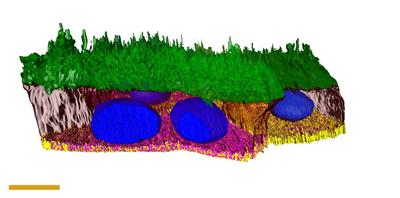Reconstruction of eye tissue gives new insight into outer retina

A new study by scientists at the University of Southampton has made a breakthrough that could help the search for treatments for age related sight loss.
With an aging society, conditions such as age-related macular degeneration (AMD) are becoming more frequent, affecting around 300 new patients every week in the UK. AMD and similar conditions currently have no effective treatments.
In this new study, published in the International Journal of Molecular Science, researchers used a newly developed imaging technique called serial block face scanning electron microscopy, to produce a digital reconstruction of eye tissues from the outer retina, at very high resolution. This is the first time this technology has been used to fully reconstruct cells from the retina and could provide new insights into the causes of irreversible blinding diseases.
The retinal pigment epithelium (RPE) is located between the neuroretina and the outer blood supply in the eye and plays a critical role in vision by looking after the photoreceptors. Scientists currently do not fully understand the causes of damage to RPE cells that leads to sight loss. The reconstructions produced in this study provides a clear picture of the 3D organisation of the RPE in a healthy eye, which will be a crucial reference point for scientists to look at how RPE cells change with age and in diseased eyes.

The research team, led by Dr Arjuna Ratnayaka, a Lecturer in Vision Sciences at the University of Southampton, used serial block face microscopy on the central mouse retina. The process involved a state of the art microscope capturing digital images of hundreds of serial layers of the retina. The team then began the painstaking process of drawing key regions of interest (such as the cell body and the nucleus) in each scanned layer before advanced computer software rendered the images into a full 3D reconstruction.
Dr Ratnayaka said, “We now understand the technical process required to produce such high resolution 3D reconstructions of retinal tissues which is an exciting foundation to carry out further studies into deteriorating cells in the eye. The use of artificial intelligence software will make this process faster in the future”.
“Our team was made up of experts in cell biology, imaging, computer science as well as ophthalmologists and shows that advances in modern research requires bringing a broad range of skills together.”
The researchers now hope that further understanding of RPE deterioration can come from using the technique to study mouse models of retinal degeneration as well as well‐preserved healthy and diseased human donor eye tissues. The study was funded by the UK Macular Society.
Animal studies were overseen by the institutions’ Ethical Research Committee and carried out in accordance with the UK Animal (Scientific Procedures) Act of 1986. Experiments also conformed to the ARVO statement for the Use of Animals in Ophthalmic and Vision Research. The experimental protocol was approved by the University of Southampton Research Ethics Committee and work carried out under the UK Home Office project licence #P395C9E5F (licence approval date: 4 July 2016).